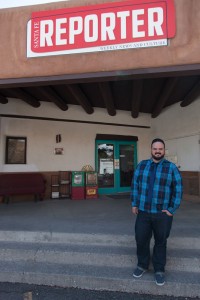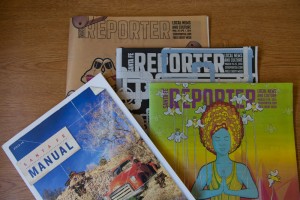Tags
Related Posts
Share This
Tales From The Trenches with Enriqué Limón
On March 26, the editors of Glyph, SFUAD’s annual publication, were graced with the presence of Enriqué Limón, the deputy editor and arts and culture editor of The Santa Fe Reporter. The editors, myself included, were able to talk with Limón on a multitude of topics, and centered in on the life of a journalist, the nature of the pitch and the art of writing copy.
Could you describe briefly what your week looks like?
Yes. Well, you know we put out this weekly product, but contrary to popular belief, we don’t just work one day a week or a couple days a week to put this together, ‘cause you’d be surprised. This is actually a daily effort, Saturdays and Sundays, most of them included as well. Usually my week kicks into high gear Mondays and Tuesdays, because those are our heavy deadline days. We publish every Tuesday around 5 p.m; the whole book has to be put to bed by then. As soon as that happens, it’s on to the next one. You know, everything from sharing information in a Google doc as to whatever content I already have contemplated for next issue and issues after that. And starting to edit pieces as they start coming in, usually first thing Wednesday morning. In my personal case, every Wednesday morning I go to Julia Goldberg’s [radio] show, promote the content of the paper, head straight into the office, and just start churning it out from there, focusing on the arts and culture content: food, music. Also, [I start to] lay out our weekly calendar, which is a little bit of the bane of my existence. It’s ever-morphing.
What is your own background as a writer? Did you set out to write this type of work?
Yeah, I sure did. This is actually what I did in Mexico, this is where I started. I started pretty young. In high school, I partook in this broadcasting journalism program and it just stuck with me. That’s where I learned how to write. What I learned how to write first were commercial spots, and as banal as that seems, it takes a lot of work to really get a message out in 20 seconds or less. So that’s what we would do: We would record ourselves and hear ourselves and sort of workshop these little spots that we would work out, and then from there it was a progression to fake radio shows, and then after that I got my own real radio show, and started working off there, and television as well. And what I found in pretty much approaching every little niche of media is that ultimately it all comes back to the source material. I found in print journalism in this day and age, at my age, I found that to be my perfect fit.
How is writing for a weekly different than writing, for instance, a poem?
I actually did write poetry back in the day, and I also wrote a couple special pieces for dailies as well. The difference being there is a lot more freedom for you to expand when you’re working for an altweekly. You have the opportunity to really find your voice and just run with it. I’ve been fortunate enough to have a couple of hell editors, which, you know, they only make you stronger, and a couple of cool ones who really are out there to help you, maybe not every single step of the way, but the bigger steps of the way. Once you get a chance to sort of hone that voice and that personality or that tone in your writing—be it fiction, non-fiction, poetry, whatever you want—then is when the magic really starts to happen. You can start pitching left and right, hopefully get published, use those clips for better things, and I’ve found in my personal journey that every little step leads to something bigger. Regardless of whether you think it’s important or not, just do it, just put your name out there, send out an email, be courteous about it, don’t expect anyone to bow down to you, and then just take it from there.
I was curious about writing for an audience. Do you think that Santa Fe is a unique audience, in a sense, or if the Reporter addresses some subsets of the population here more than others? What steps do you have to take to attract the paper to those who may not necessarily read it?
Definitely. Yeah, the Reporter, well, Santa Fe in general does have the particular thing of skewing older—not slightly older, skewing full-on older. Which, when you’re in an altweekly and you try to have that sort of, you know—the altweekly is pretty much in every major town as like the happening sort of beacon to what’s going on, underground art scenes, parties, etc.—Santa Fe isn’t quite that. But just because our audience is older I never think, ‘well, I’m writing for a 53-year-old instead of a 25-year-old.’ I just do my own thing and that’s the beauty of working for a weekly. As far as [attracting new readers], I think that being really honest and just being really on it as well as to what is going on, and trying to just cast the widest net that you can…you know, it might be a full page article on books that me, personally, I’m not really that interested in. But I put it out there because I know that there’s a huge market for that here as well. The same might be true for a piece on local features or TV shows that are being filmed here, which is a reoccurring thing, it’s always happening. But you come back every once in a while, shine a light on that, and just try to give the readers a wide perspective of what’s out there.
Beyond being wordsmiths, what do you expect from people who are going to write for your publication?
Every single bell and whistle that you bring to the table will make you stand out more than the next guy. So, for example, I have no other choice but to take my pictures. I love doing that. I’ve always just considered that an extension of my work, an extension of the package. It’s not just the gift, it’s also the box, the wrapper and the bow. So something as simple as copy-editing your own work, and proofreading and fact-checking your copy before you send it out, so it doesn’t have any garish things, not: ‘Oh, I’m done, here you go, it’s your baby now.’ Something as simple as that and then providing along with that a couple of high-resolution images that you don’t have to take yourself, you can secure those from the venue, from the band, from the museum, but the fact that you already did that step really means a lot. Hyperlinks to your story, it’s just every single other thing that you can do. [You could say] ‘Listen, I know it’s not in your budget. I already did this piece for you last month, here’s a 200-word-count follow-up.’ I’m not saying give your work away for free, but I’m saying every single thing that you do to build those relationships will pay off tenfold.
Could you speak more about building a relationship with an editor or paper?
Meeting someone in person is amazing. I already knew one or two people within the organization [of the Santa Fe Reporter], so I wasn’t just a random person off the street that happened to get their name and send out a generic pitch. So I think that really worked out for me. As far as a cold pitch, it’s really just the love that you put into it. I’m not just going to drop everything for someone I’ve never heard of or someone who hasn’t made a clear effort to get in touch with me. I mean, our offices are right in downtown Santa Fe, it’s a no-miss. Anyone can go there and introduce themselves or call me up (as long as it’s not on a Monday or Tuesday, which are heavy deadline days) and just say, ‘Listen, I have this idea.’ It’s not my job to hear you out, but I will make an effort to. And then build a relationship from there. If you want to write about art, be out every Friday at the art shows, at the art openings. If you want to write about food, tell me about this insane taco truck that no one’s ever heard of. If you want to write about movies, tell me about something that’s happening here at Greer Garson that no one knows about. Start digging your way in and then [you can say], ‘I have this thing, I’m going to give you an offer you can’t refuse. This thing that no one’s ever written about, it’s amazing, and I can do this for you.’ From there, it’s a give and take. The art of the pitch is to be tactful.
Would you recommend freelancing or trying to get into the official capacity?
I was a freelancer in San Diego for over four years, so that’s just the reality of the business nowadays. I’m not talking the 1920s, I’m talking 4 1/2 years ago I started working there and they paid me 6 cents a word. I just knew if I kept that and made magic happen, getting paid $30-$35 a column, eventually it would happen for me. It’s one of those things just keeping your eye on the prize. There is vacas flacas, like we say in Mexico, there is going to be a skinny cow period along the way. But if this is what you feel that you should be doing, do it. Do it. Nothing or no one should tell you that you shouldn’t.








 Jackalope Magazine is the student magazine of Santa Fe University of Art and Design. Building on the interdisciplinary nature of our education, we aim to showcase the talent of our university and character of our city.
Jackalope Magazine is the student magazine of Santa Fe University of Art and Design. Building on the interdisciplinary nature of our education, we aim to showcase the talent of our university and character of our city.
Recent Comments